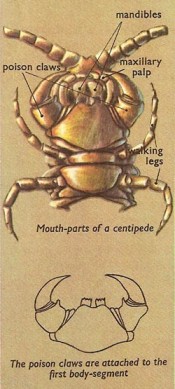
Morphology:
The form of the centipede is a unique one. The word centipede
implies 100 feet but this is often not the case. The body of a
centipede consists of a head region and the elongated trunk,
with each trunk segment having a pair of legs. The head region
contains features such as the antennae and simple eyes for
sensory perception, and mandibles and maxillae used for food man ipulation.
A key feature of the head region is the presence of modified
mandibles known as forcipules. These structures hold the venom
of the centipede, and are the appendages used to inject that
venom into their prey. The individual trunk segments of a
centipede are composed of a single pair of legs, with the end
most trunk section having thicker or "tail" legs to aid in
protection from potential predators.
ipulation.
A key feature of the head region is the presence of modified
mandibles known as forcipules. These structures hold the venom
of the centipede, and are the appendages used to inject that
venom into their prey. The individual trunk segments of a
centipede are composed of a single pair of legs, with the end
most trunk section having thicker or "tail" legs to aid in
protection from potential predators.
Respiratory system:
Centipedes, and S.gigantea do not breathe through lungs like mammals or other charismatic megafauna. Instead centipedes use a system similar to their insect relatives involving holes along the body of the organism called spiracles. These spiracles allow for gas exchange into and out of the centipede. After oxygen enters a spiracle it enters trachea, tubes that carry the gases through the centipede. This system, while not as efficient as lungs, is sufficient enough to sustain many different types of invertebrates.
Circulatory system:
Scolopendra gigantea has an open circulatory system. This means that the "blood", or in this case hemolymph, is not always contained in vessels such as veins or arteries. Instead the hemolymph fills the entire body cavity, and surrounds and immerses the organs. This hemolymph is comparable to our blood in that it houses the oxygen carrying agent, however hemolymph uses copper instead of iron as a binding agent. The negative consequence of having an open circulatory system is a decrease of pressure in the system, meaning less flow overall. The force behind the system a long hollow tube heart that runs the length of the centipedes body and contracts to move the liquid.
Venom:
Perhaps the most sinister feature of this marvelous monstrosity, the potent venom it injects into its prey is the direct reason for its success as a carnivore. This venom contains a mixture of neurotransmitters including acetylcholine, histamine, and serotonin, as well as cardio depressant factor. Essentially a smaller animal that receives a bite from this large and in charge centipede experiences paralysis but is not killed by the venom, simply immobilized and unable to act as the centipede cuts into them. While not fatal to a human, a bite will still cause swelling, pain, numbness and a weakness in the muscles.